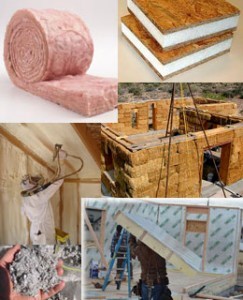Compare Insulation - Structural Insulating Panel - SIP to Other Insulations
When making the decision to build with a Structural Insulating Panel, many want to compare insulating materials. This can be a long and tedious process, so we thought we would do the work for you.
6 Categories of Insulation

Structural Insulating Panel (SIP) - Comparing Insulations
Whether building with a structural insulating panel or using other types of construction, insulation pretty much fall into one of 6 categories.
- Loose Fill– granular or fluffy material that can be poured or blown into hollow cavities or open attics
- Advantages – relatively inexpensive; properly installed, it fills the space without cutting or fitting
- Disadvantages – settles or moves around and allows air infiltration
- Batts and Blankets– made mostly from spun materials into a mat. Batts come precut lengths and blankets come in long rolls
- Advantages – inexpensive and readily available
- Disadvantages – limited R-value per inch; careful installation practices required to effectively install; compression diminishes R-value and gaps or voids allow air and moisture infiltration
- Rigid Plastic Foam– available in boards, forms or structural insulated panels made from several types of plastic foam; each has different R-values and characteristics; the standard for structural insulating panel
- Advantages – very high R-values per inch; insulation panels are some cases lightweight and easy to install; consistent R-values; resistant to water penetration at varying degrees; some can be used below grade;
- Disadvantages – some are flammable and must be protected by a fire-rated covering
- Spray Applied– primarily made from plastic foams with different R-values and performance characteristics
- Advantages – seals cavities and voids, even small spaces; higher R-values per inch
- Disadvantages – expensive; R-value diminishes with time; can shrink leaving voids; performance based on quality of installation;
- Reflective Materials – to be discussed in future post
- Other
Our next 6 posts will include charts showing the different types of insulating materials out there, compare insulating R-values per inch, talk about what they are made from and the advantages and disadvantages of each product. If you are finalizing the decision regarding the use of a structural insulating panel in your next home, take the time to visit our website - raycore.com.
RAY-CORE structural insulating panels (SIPs) are different - They are the smart structural insulating! Learn how...
By Email at: info@raycore.com or by Phone: 1.877.552.2440 or…
